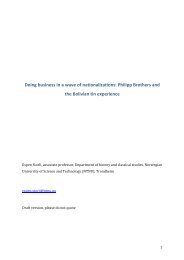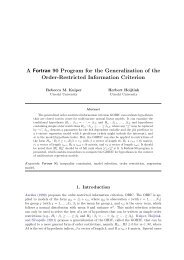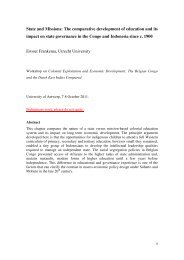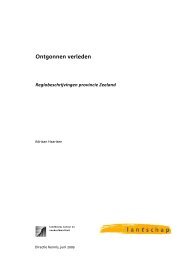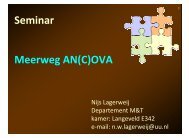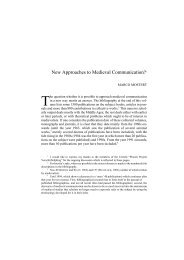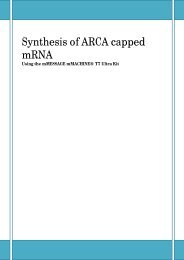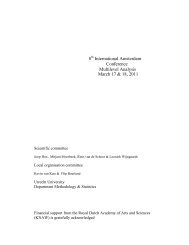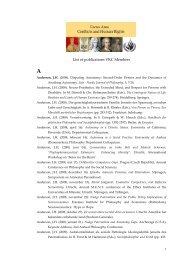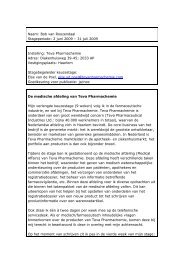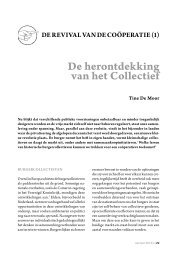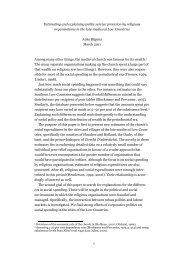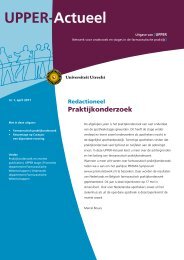Family Structure and Business Organization: Sephardic ... - Partner
Family Structure and Business Organization: Sephardic ... - Partner
Family Structure and Business Organization: Sephardic ... - Partner
You also want an ePaper? Increase the reach of your titles
YUMPU automatically turns print PDFs into web optimized ePapers that Google loves.
Draft – Not for circulation without permission<br />
These specific devolutionary <strong>and</strong> marriage practices – large dowries resulting from the<br />
50% supplement combined with consanguineal marriages <strong>and</strong> levirate unions – helped<br />
Sephardim solve the two most pressing problems facing all private merchants at the time: how to<br />
raise liquid capital <strong>and</strong> how to ensure its intergenerational transfer. Though allowed to invest in<br />
real estate, while they remained commercially active, the Livorno Sephardim kept most of their<br />
investments in movable assets. Unlike their Christian peers, they continued to endow their<br />
daughters with dowries made of cash for the most part. Profits made from trade could thus be<br />
passed from one family branch to the other via marriages, but levirate marriages assured that<br />
they never went too far.<br />
Surviving records suggest that dowries provided the most consistent influx of capital that<br />
Ergas & Silvera received on one-time occasions. As was customary, dowries <strong>and</strong> dower merged<br />
together <strong>and</strong> were registered in Ergas & Silvera’s account books. 23 When Lazzaro <strong>and</strong> Rivka<br />
Recanati exchanged vows in 1750, they also swore before a Christian notary that both the dowry<br />
<strong>and</strong> dower would be registered in the Recanati partnership’s ledgers for a total of 6,000 pieces. 24<br />
A transfer of assets for 6,000 pieces seems to characterize the threshold between the wealthiest<br />
<strong>and</strong> the middling ranks of Livorno Jews. 25 As Table 6 shows, grooms <strong>and</strong> brides of Ergas &<br />
Silvera paid each other sums oscillating between a maximum of 7,500 <strong>and</strong> a minimum of 4,500<br />
pieces of eight. Others among their relatives married with a dowry of 4,000 pieces <strong>and</strong> a dower<br />
of 2,000. 26 Dowries are good, if not exact, proxies of family wealth. We are thus not surprised<br />
can document all the financial transactions (dowry, dower <strong>and</strong> mohar) stipulated with the groom. It is written in<br />
Aramaic or in Hebrew. For a description of these documents <strong>and</strong> their potential for study of the history of Italian<br />
Jews, see VITALE 1997. The content of the ketuboth was often also recorded with Christian notaries. It is not clear<br />
why some marriage contracts in Livorno are registered in notary records <strong>and</strong> others not. It is possible that Jews went<br />
before a Christian notary to register them only when they felt the need to add further legal protection. In Rome,<br />
Papal official required this second registration; STOW 1995: 473n105.<br />
23 Because we lack Ergas & Silvera’s account books from the earlier days of the partnership, we cannot<br />
gather precise information about its capitalization. The dowries paid to Ergas & Silvera on behalf of Esther<br />
Rodrigues da Silva, Rivka Baruch Carvaglio <strong>and</strong> Deborah Ergas are recorded in ASF, LCF, 1933 (11 September<br />
1730; 22 October 1730), ASF, LCF, 1946 (22 August 1735); ASF, LCF, 1954 (21 March 1741).<br />
24 ASF, MNP, Giovanni Battista Gamerra, 25273, fols 80r-81r, no. 80. The capital was only transferred into<br />
the partnership’s accounts in 1759; ASF, MNP, Giovanni Battista Gamerra, 25277, fols 162r-163r, no. 416. The<br />
same provision had been registered in 1718 by Salvatore Recanati; ASF, MNP, Giovanni Battista Gamerra, 25271,<br />
fols 3r-4v, no. 3. As the two brothers Jacob <strong>and</strong> Daniel Navarro stated when they dissolved their partnership in<br />
Venice in 1661, they had to “purify their accounts of the dowries” before they cold divide the remaining assets<br />
among themselves; ASV, NA, Angelo Maria Piccini, 11068, fol. 162v.<br />
25 Two modest Italian Jews married in 1733 with a dowry of 400 pieces; ASF, NMP, Giovanni Giuseppe<br />
Mazzanti, 23704, fols 134r-137v, no. 121. In 1741, rabbi Abraham Joseph Canette of Istanbul married Rivka<br />
Spinosa in Livorno with a dowry of 1,200 pieces <strong>and</strong> a dower of 600; ASF, NMP, Giovanni Battista Gargani, 26272,<br />
fols 141v-142r, no. 95. My conclusion is drawn from a large but not necessarily representative sample of surviving<br />
records. More systematic comparisons would require the examination of 12 registers of ketuboth preserved in the<br />
archives of the Jewish community of Livorno, the copies of these <strong>and</strong> others ketuboth that surface among court<br />
records, <strong>and</strong> the numerous dowry contracts (confessiones dotis <strong>and</strong> restitutiones dotis) registered before Christian<br />
notaries.<br />
26 These were the sums transferred between Raphael quondam Moses Ergas <strong>and</strong> Leah Ergas (PRO, PROB,<br />
11/962, fol. 174r) <strong>and</strong> between David quondam Jacob Ergas <strong>and</strong> Sarah quondam David Nunes Franco in 1719 (ASF,<br />
NMP, Agostino Frugoni, 24732, fols 6r-7r). In 1750, Esther Attias married Jacob Ergas, son of Samuel, with a<br />
dowry of 5,000 pieces <strong>and</strong> a 50% dower; ASF, NMP, Niccolò Mazzinghi, fols 131r-v, no. 228.<br />
6



